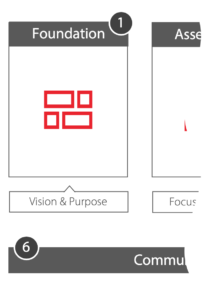Strategy Resources
OKRLet us help you demystify strategic planning
What are Objectives and Key Results (OKRs)?
OKR stands for Objectives and Key Results. OKRs are a simple management tool used to create engagement and alignment around strategic goals.
Where did OKRs come from?
OKRs first hit business headlines in 1999, when Google used them to grow from an employee base of 40 to more than 60,000 people. Since then, OKRs have been publicly adopted by a number of leading tech firms, including Twitter, Spotify, LinkedIn and Airbnb. They have also moved into mainstream business usage, with big firms such as Walmart, Target, The Guardian, Dun & Bradstreet and ING Bank now on board.
The strategic link
Why are we talking about the OKR methodology? Because Objectives and Key Results must be used as part of a broader strategic process. They mustn’t be developed in isolation if they are to have genuine strategic value – otherwise, they become a random tactical tool!
How do OKRs differ from other planning approaches?
Objectives and Key Results are regularly agreed, measured and evaluated – typically on a quarterly basis. The approach is simple and fast-paced so that it can fully engage the creativity and productivity of each team. They also help with organisational alignment, by making sure every team and employee has set priorities, an energised pace, and a clear direction of travel.
What are the concept’s components?
The OKR format was created by John Doerr; one of the world’s most successful VC’s, who began his career at Intel. Doerr created this formula for goal setting, which he went on to share with Google. The OKR formula is actually very simple and has two parts. It simply states:
I will (do X) as measured by (Y)
Let’s look at each of the two parts more closely:
1. ‘I will do’ or Setting Objectives – This is the first qualitative part of the statement and it should be inspirational, engaging, motivating and brief. It should also challenge the team charged with delivering it!
2. ‘As measured by’, AKA: Defining Key Results – The key results are the metrics used to measure progress towards the objective. Every objective needs to have 2-5 of these. Any more and your employees will start to lose focus. Remember, they must use a numerical measure, otherwise the objective simply becomes a nebulous desire, rather than anything tangible.
An Example
Our objective could be:
“Deliver a world-class customer experience”. This satisfies the criteria described above, in being inspirational, brief and motivating – not to mention challenging!
But how can we apply measurement to make it into a goal? We could consider repeat purchases, customer satisfaction scores or referral marketing leads. For balance, we could add a measure for the cost of customer acquisitions. This would ensure that the business was managing its costs whilst keeping customers happy; for the perfect, profitable balance.
Different teams can focus on the same Objective, but use local Key Results that are meaningful for their functional area and roles. In the example above, the marketing team might have a digital engagement measurement such as the bounce rate or conversions to a specific landing page. The logistics team might have a measurement related to fulfilment times.
Key things to note about the OKR approach:
OKR planning is:
1. Responsive: OKR uses an agile approach to goal planning by adding in a short goal cycle. This helps companies to be more responsive and adaptive to change.
2. Simple: It’s easy to use and lightweight. Time is spent on achieving goals, rather than developing them.
3. Transparent: The organisation is aligned, as OKRs are shared across the entire organisation. Often, leadership teams share their own OKRs openly on the corporate intranet.
4. Varied in tempo: The approach recognises that different rhythms are needed for delivery. Strategic OKRs might be annual, tactical could be quarterly and operational weekly.
5. Not top-down: OKRs are top-down and bottom-up simultaneously. There is no time-consuming cascade. Strategic OKRs are set at company level and then each team is empowered to set its own tactical level OKRs.
6. Bold: The model says that if you reach your goals all of the team, they are too easy. OKRs should be ambitious and bold stretch goals; encouraging teams to think in new and creative ways to optimise their performance.
7. Not linked to individual evaluation: OKRs are for managers to encourage a go-getting, productive culture – one that tries new things and is innovative. They aren’t used to evaluate individuals. Why? Because if people fear losing out on bonuses through risk-taking, they simply won’t risk creativity.
Taking it forward
To use the OKR approach, companies will need to take their time to adapt their culture. Set a few top priorities and choose hard measures which evidence their achievement. Ask, ‘what is the most pressing priority for this business quarter?’ Talk to other internal teams for the alignment angle too, so that OKRs make sense strategically and link together. Once OKRs are in place, discuss them daily, bring them to life and drive focus so that they are followed through.
Using OKRs within your strategic planning process
OKR’s work as a part of the Intrafocus Strategic Planning Process (SPP). They fall readily into:
- Step 3: Objectives – Setting Objectives in SSP
- Step 4: KPIs – Creating meaningful KPIs in SSP
- Step 5: Projects – Defining projects in SPP
At Intrafocus, we can help your business to develop a valuable strategic process based on a methodology that works for your unique needs – incorporating tools such as OKR. Contact us for more information about how we can contextualise these types of tools for your strategic needs.
The key takeaway
And if you remember just one thing about using Objectives and Key Results – it’s to link them intrinsically to your strategic planning process!
Resources:
For information on how to create clear objectives and goals and how to design meaningful key performance indicators, download our strategy workbook:
Strategic Planning Process
The Intrafocus Strategic Planning Process or SPP, utilises OKR in steps three, four and five. see the whole process here:
Strategic Planning Process (SPP)


